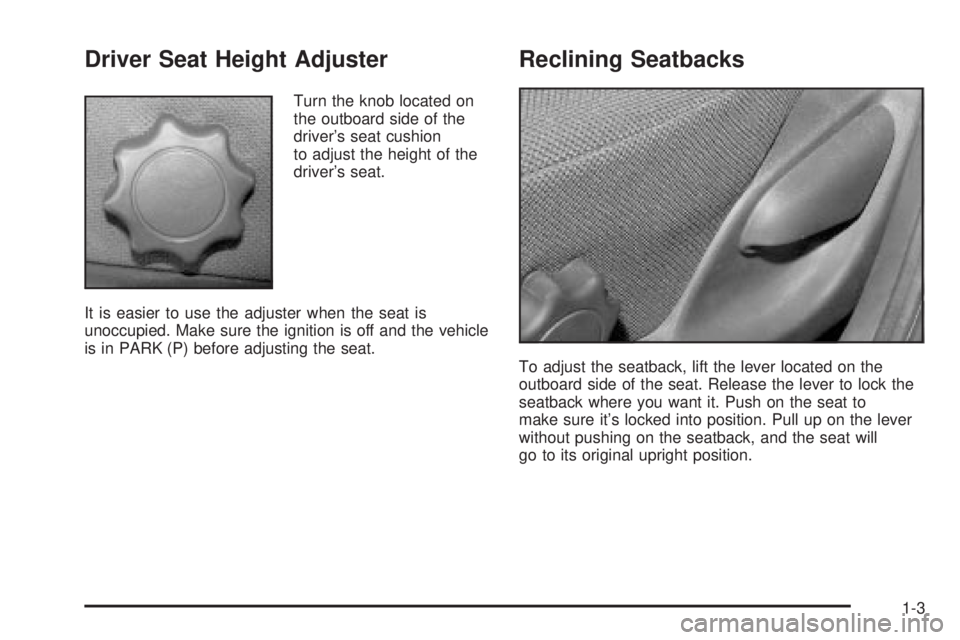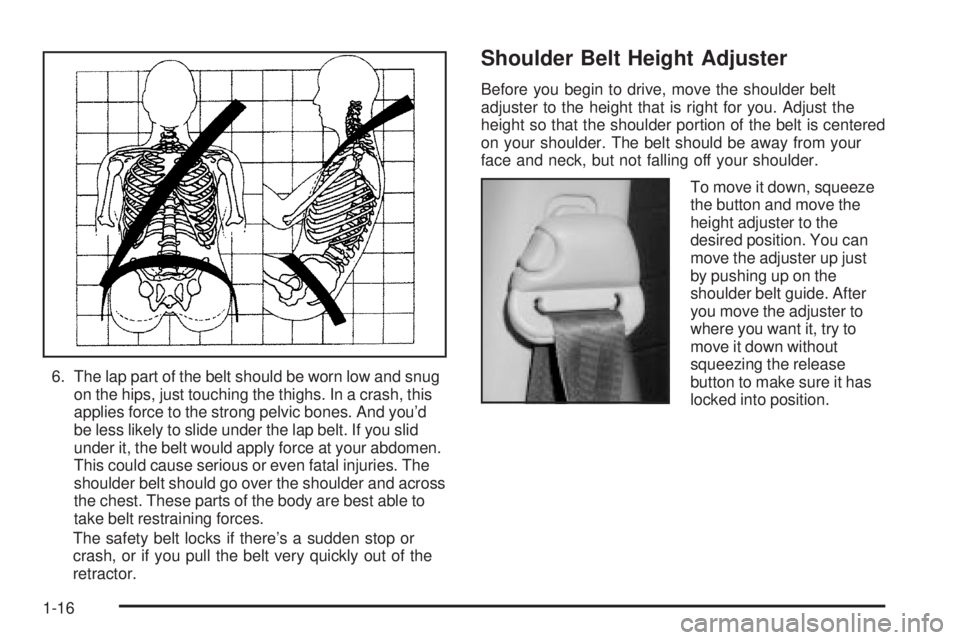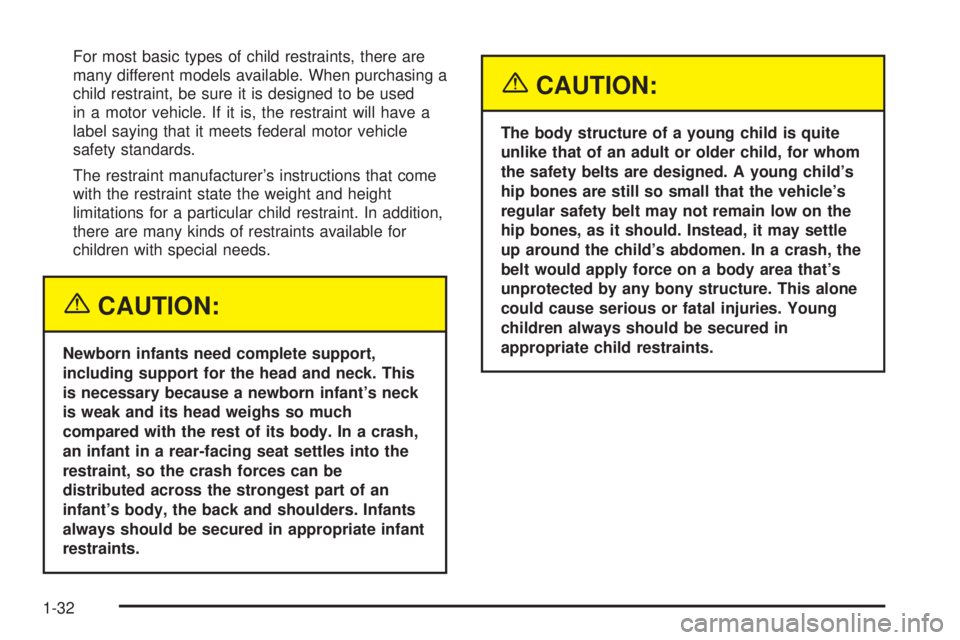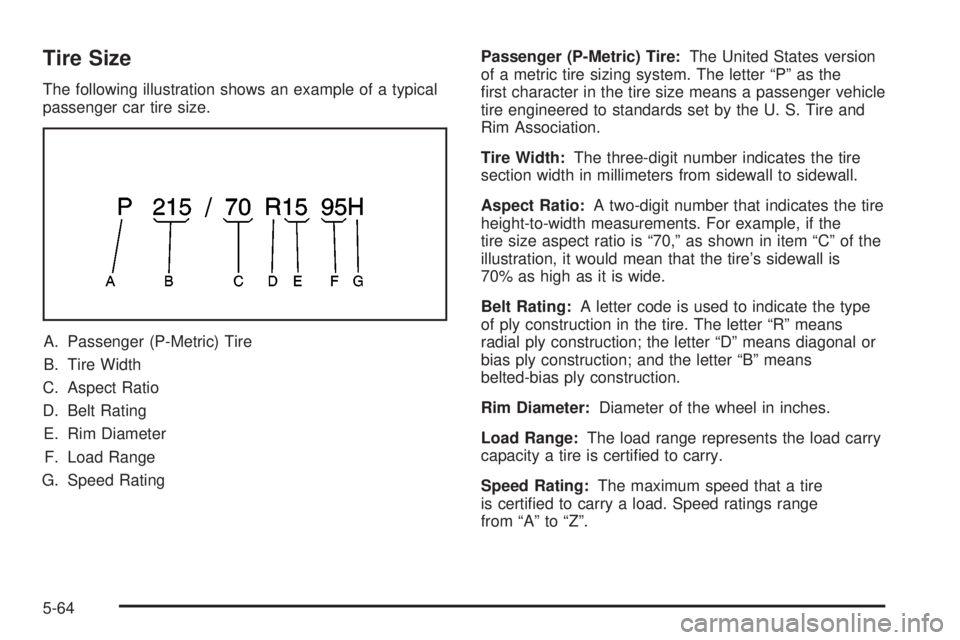height PONTIAC VIBE 2004 Owners Manual
[x] Cancel search | Manufacturer: PONTIAC, Model Year: 2004, Model line: VIBE, Model: PONTIAC VIBE 2004Pages: 370, PDF Size: 2.68 MB
Page 7 of 370

Front Seats......................................................1-2
Manual Seats................................................1-2
Driver Seat Height Adjuster..............................1-3
Reclining Seatbacks........................................1-3
Head Restraints.............................................1-5
Passenger Folding Seatback............................1-5
Rear Seats.......................................................1-7
Rear Seat Operation.......................................1-7
Safety Belts.....................................................1-8
Safety Belts: They Are for Everyone.................1-8
Questions and Answers About Safety Belts......1-13
How to Wear Safety Belts Properly.................1-14
Driver Position..............................................1-14
Safety Belt Use During Pregnancy..................1-21
Right Front Passenger Position.......................1-22
Rear Seat Passengers..................................1-22
Safety Belt Pretensioners...............................1-26
Safety Belt Extender.....................................1-26
Child Restraints.............................................1-27
Older Children..............................................1-27
Infants and Young Children............................1-29
Child Restraint Systems.................................1-33Where to Put the Restraint.............................1-36
Top Strap....................................................1-36
Top Strap Anchor Location.............................1-38
Lower Anchorages and Top Tethers
for Children (LATCH System)......................1-39
Securing a Child Restraint Designed
for the LATCH System...............................1-41
Securing a Child Restraint in a
Rear Seat Position....................................1-42
Securing a Child Restraint in the
Right Front Seat Position............................1-44
Supplemental Restraint System (SRS)..............1-47
Where Are the Air Bags?...............................1-50
When Should an Air Bag In¯ate?....................1-52
What Makes an Air Bag In¯ate?.....................1-53
How Does an Air Bag Restrain?.....................1-53
What Will You See After an Air Bag In¯ates?.......1-54
Servicing Your Air Bag-Equipped Vehicle.........1-56
Restraint System Check..................................1-56
Checking Your Restraint Systems...................1-56
Replacing Restraint System Parts
After a Crash............................................1-57
Section 1 Seats and Restraint Systems
1-1
Page 9 of 370

Driver Seat Height Adjuster
Turn the knob located on
the outboard side of the
driver's seat cushion
to adjust the height of the
driver's seat.
It is easier to use the adjuster when the seat is
unoccupied. Make sure the ignition is off and the vehicle
is in PARK (P) before adjusting the seat.
Reclining Seatbacks
To adjust the seatback, lift the lever located on the
outboard side of the seat. Release the lever to lock the
seatback where you want it. Push on the seat to
make sure it's locked into position. Pull up on the lever
without pushing on the seatback, and the seat will
go to its original upright position.
1-3
Page 22 of 370

6. The lap part of the belt should be worn low and snug
on the hips, just touching the thighs. In a crash, this
applies force to the strong pelvic bones. And you'd
be less likely to slide under the lap belt. If you slid
under it, the belt would apply force at your abdomen.
This could cause serious or even fatal injuries. The
shoulder belt should go over the shoulder and across
the chest. These parts of the body are best able to
take belt restraining forces.
The safety belt locks if there's a sudden stop or
crash, or if you pull the belt very quickly out of the
retractor.
Shoulder Belt Height Adjuster
Before you begin to drive, move the shoulder belt
adjuster to the height that is right for you. Adjust the
height so that the shoulder portion of the belt is centered
on your shoulder. The belt should be away from your
face and neck, but not falling off your shoulder.
To move it down, squeeze
the button and move the
height adjuster to the
desired position. You can
move the adjuster up just
by pushing up on the
shoulder belt guide. After
you move the adjuster to
where you want it, try to
move it down without
squeezing the release
button to make sure it has
locked into position.
1-16
Page 37 of 370

{CAUTION:
Children who are up against, or very close to,
any air bag when it in¯ates can be seriously
injured or killed. Air bags plus lap-shoulder
belts offer outstanding protection for adults and
older children, but not for young children and
infants. Neither the vehicle's safety belt system
nor its air bag system is designed for them.
Young children and infants need the protection
that a child restraint system can provide.
Q:What are the different types of add-on child
restraints?
A:Add-on child restraints, which are purchased by
the vehicle's owner, are available in four basic
types. Selection of a particular restraint should take
into consideration not only the child's weight,
height, and age but also whether or not the
restraint will be compatible with the motor vehicle
in which it will be used.
1-31
Page 38 of 370

For most basic types of child restraints, there are
many different models available. When purchasing a
child restraint, be sure it is designed to be used
in a motor vehicle. If it is, the restraint will have a
label saying that it meets federal motor vehicle
safety standards.
The restraint manufacturer's instructions that come
with the restraint state the weight and height
limitations for a particular child restraint. In addition,
there are many kinds of restraints available for
children with special needs.
{CAUTION:
Newborn infants need complete support,
including support for the head and neck. This
is necessary because a newborn infant's neck
is weak and its head weighs so much
compared with the rest of its body. In a crash,
an infant in a rear-facing seat settles into the
restraint, so the crash forces can be
distributed across the strongest part of an
infant's body, the back and shoulders. Infants
always should be secured in appropriate infant
restraints.
{CAUTION:
The body structure of a young child is quite
unlike that of an adult or older child, for whom
the safety belts are designed. A young child's
hip bones are still so small that the vehicle's
regular safety belt may not remain low on the
hip bones, as it should. Instead, it may settle
up around the child's abdomen. In a crash, the
belt would apply force on a body area that's
unprotected by any bony structure. This alone
could cause serious or fatal injuries. Young
children always should be secured in
appropriate child restraints.
1-32
Page 253 of 370

Brake Wear
The GT series has four-wheel disc brakes. All other
models have front disc brakes and rear drum brakes.
Disc brake pads have built-in wear indicators that make
a high-pitched warning sound when the brake pads
are worn and new pads are needed. The sound
may come and go or be heard all the time your vehicle
is moving (except when you are pushing on the
brake pedal ®rmly).
{CAUTION:
The brake wear warning sound means that
soon your brakes will not work well. That
could lead to an accident. When you hear the
brake wear warning sound, have your vehicle
serviced.
Notice:Continuing to drive with worn-out brake
pads could result in costly brake repair.
Some driving conditions or climates may cause a brake
squeal when the brakes are ®rst applied or lightly
applied. This does not mean something is wrong with
your brakes.Properly torqued wheel nuts are necessary to help
prevent brake pulsation. When tires are rotated, inspect
brake pads for wear and evenly tighten wheel nuts in
the proper sequence to GM torque speci®cations.
If you have rear drum brakes, they do not have wear
indicators, but if you ever hear a rear brake rubbing
noise, have the rear brake linings inspected immediately.
Also, the rear brake drums should be removed and
inspected each time the tires are removed for rotation or
changing. When you have the front brake pads
replaced, have the rear brakes inspected, too.
Brake linings should always be replaced as complete
axle sets.
See
Brake System Inspection on page 6-25.
Brake Pedal Travel
See your dealer if the brake pedal does not return to
normal height, or if there is a rapid increase in
pedal travel. This could be a sign of brake trouble.
Brake Adjustment
Every time you make a moderate brake stop, your disc
brakes adjust for wear. If you rarely make a moderate
or heavier stop, then your brakes might not adjust
correctly. If you drive in that way, then Ð very
carefully Ð make a few moderate brake stops about
every 1,000 miles (1 600 km), so your brakes will
adjust properly.
5-43
Page 273 of 370

A. Tire Size
B. Department of Transportation (DOT)
C. Tire Identi®cation Number (TIN)
D. Tire Ply Material
E. Uniform Tire Quality Grading (UTQG)
F. Maximum Cold In¯ation Load Limit
Tire Size:The tire size is a combination of letters and
numbers used to de®ne a particular tire's width,
height, aspect ratio, construction type and service
description. See the ªTire Sizeº illustration later in this
section for more detail.
Department of Transportation (DOT):The
Department of Transportation (DOT) code indicates that
the tire is in compliance with the U.S. Department of
Transportation Motor Vehicle Safety Standards.Tire Identi®cation Number (TIN):The letters and
numbers following DOT code are the Tire Identi®cation
Number (TIN). The TIN shows the manufacturer and
plant code, tire size, and date the tire was manufactured.
The TIN is molded onto both sides of the tire.
Tire Ply Material:The type of cord and number of plies
in the sidewall and under the tread.
Uniform Tire Quality Grading (UTQG):Tire
manufacturers are required to grade tires based on
three performance factors: treadwear, traction and
temperature resistance. For more information see
Uniform Tire Quality Grading on page 5-72.
Maximum Cold In¯ation Load Limit:Maximum load
that can be carried and the maximum pressure
needed to support that load. For information on
recommended tire pressure see
In¯ation Ð Tire
Pressure on page 5-67andLoading Your Vehicle on
page 4-32.
5-63
Page 274 of 370

Tire Size
The following illustration shows an example of a typical
passenger car tire size.
A. Passenger (P-Metric) Tire
B. Tire Width
C. Aspect Ratio
D. Belt Rating
E. Rim Diameter
F. Load Range
G. Speed RatingPassenger (P-Metric) Tire:The United States version
of a metric tire sizing system. The letter ªPº as the
®rst character in the tire size means a passenger vehicle
tire engineered to standards set by the U. S. Tire and
Rim Association.
Tire Width:The three-digit number indicates the tire
section width in millimeters from sidewall to sidewall.
Aspect Ratio:A two-digit number that indicates the tire
height-to-width measurements. For example, if the
tire size aspect ratio is ª70,º as shown in item ªCº of the
illustration, it would mean that the tire's sidewall is
70% as high as it is wide.
Belt Rating:A letter code is used to indicate the type
of ply construction in the tire. The letter ªRº means
radial ply construction; the letter ªDº means diagonal or
bias ply construction; and the letter ªBº means
belted-bias ply construction.
Rim Diameter:Diameter of the wheel in inches.
Load Range:The load range represents the load carry
capacity a tire is certi®ed to carry.
Speed Rating:The maximum speed that a tire
is certi®ed to carry a load. Speed ratings range
from ªAº to ªZº.
5-64
Page 275 of 370

Tire Terminology and De®nitions
Air Pressure:The amount of air inside the tire pressing
outward on each square inch of the tire. Air pressure
is expressed in pounds per square inch (psi) or
kilopascal (kPa).
Accessory Weight:This means the combined weight
of optional accessories, for example, automatic
transmission, power steering, power brakes, power
windows, power seats, radio and air conditioning.
Aspect Ratio:The relationship of a tire's height to
its width.
Belt:A rubber coated layer of cords that is located
between the plies and the tread. Cords may be made
from steel or other reinforcing materials.
Bead:The tire bead contains steel wires that hold the
tire onto the rim.
Bias Ply Tire:A pneumatic tire in which the ply cords
that extend to the beads are laid at alternate angles
substantially less than 90 degrees to the centerline of
the tread.
Cold In¯ation Pressure:The amount of air pressure in
a tire, measured in pounds per square inch (psi) or
kilopascal (kPa), before a tire has built up heat
from driving. See
In¯ation -- Tire Pressure on page 5-67.Curb Weight:This means the weight of a motor
vehicle with standard and optional equipment including
the maximum capacity of fuel, oil and coolant, without
passengers and cargo.
DOT Markings:A code molded into the sidewall of a
tire signifying that the tire is in compliance with the
U.S. Department of Transportation motor vehicle safety
standards. The DOT code includes the Tire Identi®cation
Number (TIN), an alphanumeric designator which can
also identify the tire manufacturer, production plant,
brand and date of production.
GVWR:Gross Vehicle Weight Rating, see
Loading
Your Vehicle on page 4-32.
GAWR FRT:Gross Axle Weight Rating for the front
axle, see
Loading Your Vehicle on page 4-32.
GAWR RR:Gross Axle Weight Rating for the rear axle,
see
Loading Your Vehicle on page 4-32.
Intended Outboard Sidewall:The side of an
asymmetrical tire that must always face outward when
mounted on a vehicle.
Kilopascal (kPa):The metric unit for air pressure.
There are 6.9 kPa's to one psi.
Light Truck (LT-Metric) Tire:A tire used on light duty
trucks and some multipurpose passenger vehicles.
5-65
Page 284 of 370

Wheel Replacement
Replace any wheel that is bent, cracked or badly rusted
or corroded. If wheel nuts keep coming loose, the
wheel, wheel bolts and wheel nuts should be replaced.
If the wheel leaks air, replace it (except some
aluminum wheels, which can sometimes be repaired).
See your dealer if any of these conditions exist.
Your dealer will know the kind of wheel you need.
Each new wheel should have the same load-carrying
capacity, diameter, width, offset and be mounted
the same way as the one it replaces.
If you need to replace any of your wheels, wheel bolts
or wheel nuts, replace them only with new GM
original equipment parts. This way, you will be sure to
have the right wheel, wheel bolts and wheel nuts
for your vehicle.{CAUTION:
Using the wrong replacement wheels, wheel
bolts or wheel nuts on your vehicle can be
dangerous. It could affect the braking and
handling of your vehicle, make your tires lose
air and make you lose control. You could have
a collision in which you or others could be
injured. Always use the correct wheel, wheel
bolts and wheel nuts for replacement.
Notice:The wrong wheel can also cause problems
with bearing life, brake cooling, speedometer or
odometer calibration, headlamp aim, bumper height,
vehicle ground clearance and tire or tire chain
clearance to the body and chassis.
See
Changing a Flat Tire on page 5-77for more
information.
5-74